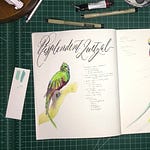Thank you , , , , , and many others for tuning into my live video!
Hi friends!
I always think “bugs” are my least favorite subject to draw until I start working on them. I marvel at how well they are put together. Like everything in nature, every part is purposeful — from the antennae to the wing casings to the segments of the legs. The more I study them the more fascinated I become, and soon I’m wondering why don’t I draw insects more often?
When I was planning this week’s theme about “incidental pollinators” the ladybug, or ladybird, was in my mind for our subject (and paid subscribers will have many to choose from in the practice photo pack below). It was only after doing some research, that I discovered our subject this week, the European Rose Chafer (Cetonia aurata). (Not to be confused with the North American Rose Chafer, Macrodactylus subspinosus, which is brown, not iridescent, and about half the size of the Cetonia aurata.)
Rose Chafer (Cetonia aurata) or Japanese Beetle (Papilla japonica)
Years ago, I grew small Alpine strawberries in containers hanging off my front porch railing. This was the spring/summer Olivia, a charming zipper-spider, came to stay with us — a guest in one of the bushes right next to the porch stairs. It was also the year the Japanese Beetles visited and ate most of the strawberries (and leaves). Not very polite guests, but Olivia found them quite delicious! I wrote about her in the fourth issue of the Tiny Owl Dispatch back in September 2023, and I’ve removed the paywall if you’d like to know more about her.
When I was studying the Rose Chafer, using the framework I Notice I Wonder It Reminds Me Of , this beetle reminded me of that summer and those beetles. They look remarkably similar, and are related as they are both part of the scarab family. Both feed off of nectar and flowers. Both are like little jewels.
You won’t find Rose Chafer (Cetonia aurata) beetles in the United States, but you will find plenty Japanese beetles — they are considered invasive here. They decimated my strawberry plants, but kept Olivia fed, and she in turn kept the mosquitos and black flies away. And I now know that the Japanese beetles were probably part of a very helpful army of pollinators, including honey bees, bumble bees, Ruby-throated Hummingbirds, a host of songbirds and other insects, who helped my lilac bush, wild blackberry bushes, and all the flora in the forest surrounding my home thrive.
xoSusannah
P.S. Keep scrolling for this week’s prompt.
P.P.S. What’s on my easel this week? Keep scrolling to find out!
P.P.P.S. Join this episode’s chat to share your journal pages, your thoughts, and cheer on others!
Resources
https://www.inaturalist.org/taxa/52402-Cetonia-aurata
https://www.inaturalist.org/taxa/67760-Popillia-japonica
Livestream Notes
Welcome & Intro (Time Stamp 00:00)
Drawing (Time Stamp 05:05)
Some Principles Of Working With Watercolor (Time Stamp 34:06)
Painting (Time Stamp 52:17)
Coming Next (Time Stamp 2:14.05)
Wonder-Filled Wednesday
Every Wednesday at 1:30pm Eastern US time (Time Converter), we marvel in our nature journals together — draw along with me or just watch, ask questions, etc. Livestreams are hosted on Substack for everyone, and recorded/archived for paid subscribers.
To join me live on your computer, look for my email notification. Or to watch on your phone download the app:
Prompt And Extra References For Practice
Listen to this episode with a 7-day free trial
Subscribe to Cricklewood Nature Journal to listen to this post and get 7 days of free access to the full post archives.













